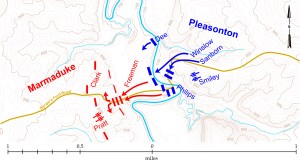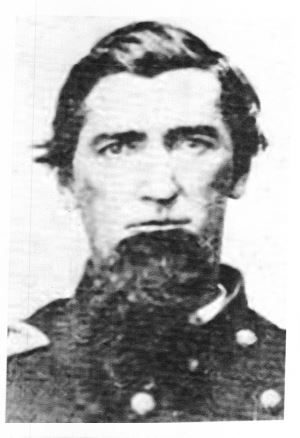Search:
Powered by
Website Baker
Tour Stop, “Attack by Dee's Battalion”
[Waypoint = 39.020839, -94.522583]
Directions
Walk west to where the pavement for E 60th Street begins. Walk north on Colorado Avenue for one block. Turn right (east) onto E 59th Street and then take a quick left (north) on Cindy Avenue. Walk north about 0.2 miles, crossing E 58th Street, until you reach a wide gravel path going down to the Big Blue River. Follow the path all the way to the river. If you look a little upstream on the opposite bank, you should be able to see where the “Dee’s Battalion” ravine drains into the river. You may also be able to make out the tree with two yellow paint dots marking the location of the Dee’s Battalion River Crossing position.
Description
|
Map of Federal crossing at Byram's Ford on October 23, 1864 by theCivilWarMuse based on USGS 1935 Kansas City Quadrangle (Click map for larger image) |
When the Federal attack began, Colonel Edward F. Winslow sent the Third Battalion, Fourth Iowa Cavalry, commanded by Captain Edward W. Dee, down river to the right. Captain Dee led the Third Battalion down a ravine to the Big Blue River just opposite from where you are standing. The Third Battalion did get across the river and then swept around to the southwest to attack the Confederate left flank. Dee’s Third Battalion was armed with the superior firepower of Spencer repeating rifles. The Spencer rifle used rim fire metal cartridges and could be fired 7 times before needing to be reloaded. Reloading was a simple matter of swapping tubes out of the rifle’s stock. The Third Battalion’s attack surprised the Confederates forcing them to withdraw across the open ground to their main defense line. This took some of the pressure off the First and Fourth Brigades, who were able to get across the river.
Historical Vignettes
|
Major Abial R. Pierce courtesy of the Battle of Westport Museum |
Major Abial R. Pierce, commanding Fourth Iowa Cavalry, wrote about sending Dee’s Battalion to the right.
"The Third Battalion of the Fourth Iowa, under Captain Dee, which had been watching during the night, was concentrated and sent to the right, with orders to wade the stream and effect a lodgment on the other bank … The third battalion, although considered relieved by General Brown's troops, were ordered by Colonel Winslow to make the charge across the river, which they did gallantly, using their Spencer carbines with great effect upon the enemy, who retreated precipitately to his main line."

